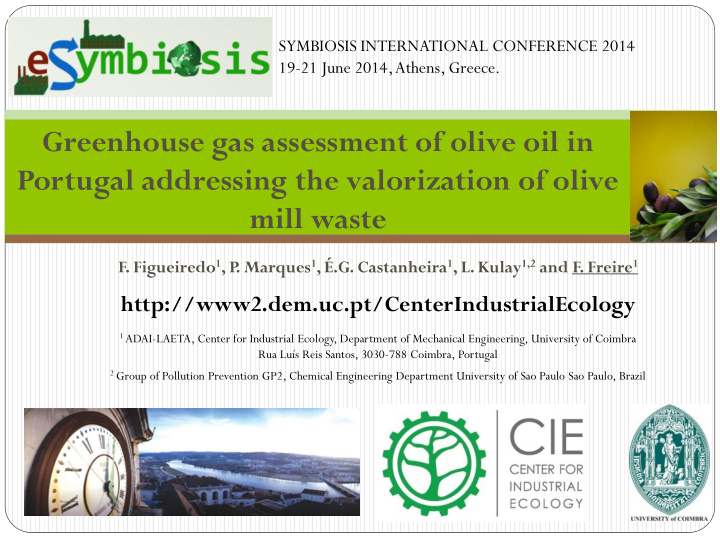



SYMBIOSIS INTERNATIONAL CONFERENCE 2014 19-21 June 2014, Athens, Greece. Greenhouse gas assessment of olive oil in Portugal addressing the valorization of olive mill waste . Marques 1 , É.G. Castanheira 1 , L. Kulay 1,2 and F. Freire 1 F. Figueiredo 1 , P http://www2.dem.uc.pt/CenterIndustrialEcology 1 ADAI-LAETA, Center for Industrial Ecology, Department of Mechanical Engineering, University of Coimbra Rua Luís Reis Santos, 3030-788 Coimbra, Portugal 2 Group of Pollution Prevention GP2, Chemical Engineering Department University of Sao Paulo Sao Paulo, Brazil
Outline Introduction Motivation Objective Methods Life-Cycle Model and Inventory Multifunctionality Results Conclusions 2
Motivation Olive cultivation and olive oil extraction are important activities in Portugal and other Mediterranean countries. In 2013 represented 343 million euro Olive oil production in Portugal Three-phase extraction Two-phase extraction (olive oil; pomace ; olive mill wastewaters) (olive oil; wet pomace ) can be recovered (chemical extraction, with hexane) olive pomace oil and extracted pomace 3
Main Objective Present a comparative a GHG life-cycle assessment (LCA) of olive oil produced from three and two-phase extraction mills, addressing the valorization of olive pomace (produced with olive oil) to produce olive pomace oil and extracted pomace LCA methodology 4
Life-cycle model 5
Inventory - Cultivation • An intensive cultivation system Intensive Units Inputs producer (per ha) Fertilizers • 71% of the total olive N 110 kg production in Portugal in 2013 P 48.0 kg K 129 kg Urea 37.5 kg • require irrigation Borum 0.47 kg Pesticides (a.s.) Copper oxychloride 10.0 kg • High level of fertilization and Tubeconazol 0.15 kg phytosanitary control Glyphosate 2.90 kg Dimethoate 3.60 kg • Energy Productivity of about 10 Diesel 86.0 L tonnes per hectare Gasoline 14.0 L Electricity 880 kWh Water 2000 m 3 6
Inventory – extraction Olive oil Olive pomace oil Three-phase Two-phase Three-phase Two-phase Unit Units Inputs olive pomace olive pomace Inputs olive mill olive mill (per L) (per t) oil mill oil mill Olives 5.89 5.89 kg Olive pomace 16 41 t Electricity 0.269 0.269 kWh Electricity 78 95 kWh Propane 0.01 - kg Diesel 20 50 L Water 4.82 1.24 L Hexane 1.1 1.1 kg Outputs Extracted pomace 0.6 1.85 t Olive oil 1.00 1.00 L Products Pomace 2.99 4.2 kg Extracted pomace 8.60 7.35 t Olive pomace oil 1 1 t • The efficiency was considered similar • Drying of pomace from two-phase from both types of extraction ; mill requires more energy • Two-phase extraction originates olive • Pomace from two-phase mill oil and wet pomace with 80% originates less extracted pomace moisture (mc wb), which hinders and olive pomace transportation. • Three-phase extraction generate olive oil , pomace (40% mc wb) and olive 7 mill wastewater (aerobic lagoons).
Mu Mult ltifun functionality ctionality: : price ce ba based ed al allo location cation vs vs. . substitution (“avoided burdens”) (1 (1) Olive oil production is a multifunctional process Price allocation: Price allocation Mass quantities Typology Co-product Price (kg/L olive oil ) Factor ( € /t) olive oil is 220 Olive oil 0.895 5587 98.5% 3 phase Olive oil Pomace 2.99 (b) 25 1.5% higher than pomace extraction Olive oil 0.895 5587 99.6% olive oil is 1100 2 phase 4.2 (c) Wet Pomace 5 0.4% higher than pomace Price allocation in olive oil production is approximately the same that allocating all impacts to olive oil 8
Mu Mult ltifunc function tionality ality: : price ce ba based d al allo location cation vs. . substitution (“avoided burdens”) (2 (2) Substitution considers that there is an alternative way of generating the exported functions co-products That are used in other system that is out of the boundaries of the first one Biodiesel production Heat process in ceramic industries The credits for the avoided-burdens should be subtracted from the total burdens of the olive pomace oil extraction process 9
Results – GHG emissions 2 phase was the lower GHG emissions 3 phase was the lower GHG emissions credits multifunctionality approach influences the results and reverses the rank order of the extraction process that led to the lowest olive oil GHG intensity 10
Cultivation results – Main contributors to GHG emissions 11
Conclusions (1) Cultivation was the life-cycle phase that contributes more to the total GHG intensity of olive oil production, followed by packing ; Multifunctionality approaches significantly influences the results and even reverses the rank order of the extraction process that led to the lowest olive oil GHG intensity; Price allocation : olive oil from two-phase extraction has the lowest GHG emissions; “ Avoided burdens approach ”: olive oil from three- phase extraction has the lowest GHG emissions; 12
Conclusions (2) Results with “ avoided burdens ” are highly dependen t on the credits associated with the virgin oil (there is a huge variation in the literature) displacing olive pomace oil; This study shows the importance of olive pomace valorization to promote an industrial ecology system in olive oil chain and reduce the life-cycle GHG intensity of olive oil; Work within the on-going project (ECODEEP) supporting this research is addressing other types of wastewater treatment systems and environmental impact categories. 13
SYMBIOSIS INTERNATIONAL CONFERENCE 2014 19-21 June 2014, Athens, Greece. Thank you, Questions and Comments Greenhouse gas assessment of olive oil in Portugal addressing the valorization of olive mill waste F. Figueiredo, P . Marques, É.G. Castanheira, L. Kulay and F. Freire http://www2.dem.uc.pt/CenterIndustrialEcology Acknowledgements This research was supported by project ECODEEP (Eco-efficiency and Eco-management in the Agro Industrial sector, FCOMP – 05 – 0128 – FEDER – 018643), EMSURE - Energy and Mobility for SUstainable Regions (CENTRO-07-0224-FEDER- 002004) and the Portuguese Science and Technology Foundation projects: PTDC/SEN-TRA/117251/2010 and PTDC/EMS- ENE/1839/2012.
Recommend
More recommend